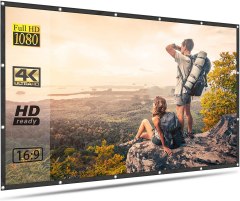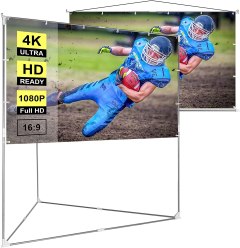Buying guide for Best outdoor projector screens
A movie under the stars on a warm summer night makes for a unique and unforgettable experience. All you need is a portable projector and an outdoor projector screen to suit your space and needs. Maybe some blankets and a bowl of popcorn, too.
Projection screens are white (or off-white) and tend to be made from PVC or polyester. A good outdoor projector screen can help optimize the viewing experience by brightening the projected image. What’s more, distortion is diminished when the screen is viewed from wide angles. Using a quality projector, you can recreate a credible home theater or movie theater experience for your friends and family — outside!
A projector screen can be hung on a wall or from a tree, or it can be erected on a stand. Hanging options include ropes, screws, or tacks. Stands may have two, three, or four legs on which to rest. Screens come in various sizes, measured by diagonal length. A worthy projector screen is a vital part of an enjoyable outdoor viewing experience, and we can help you find the one that best suits your needs.
Key considerations
The projector
When shopping for a screen, consider the quality and specs of your projector. Ideally, you want to match the quality of your projector to the quality of your new screen. Projector specs will advise the optimal distance from the screen. They will also tell you how large of an image can be projected before the image loses quality.
Setting up
As mentioned, outdoor projector screens are either affixed to an existing structure or placed on a stand. Some screens are designed to be set up using either method, but some aren’t; make sure you know the proper setup of any screen you’re considering.
Hanging or mounted screens use ropes, tacks, or screws to attach to walls, fences, or trees. Outdoor projector screens that come with stands are ideal for open spaces, such as parks and campgrounds. Bear in mind that a screen with an included stand may be easier to set up, but a hanging screen may perform better in windy weather.
Size
Outdoor projector screens generally range from 80 to 120 inches, with some even larger. While bigger may seem better, consider how many people will be watching regularly and what spaces it will be used in. If you’re expecting a big crowd, a larger screen will be necessary. For more intimate gatherings, a smaller screen may suffice. If the theater screen is going on the patio or in the backyard, make sure you have the amount of space required.
Location and mobility
If you plan to use the screen at a campground, park, or anywhere that isn’t your backyard, it’s best to purchase an outdoor projector screen that comes with a stand and travel case. If the backyard is the main location for viewing, then mobility is less of a factor.
Usage
How often you intend to use the projector may inform the price range in which you search. If you are an avid camper or often screen movies in your backyard theater, investing in a durable, high-quality screen may be best for the long-term. However, if you anticipate fewer occasions of outdoor movie viewing, it may be best to start with a lower-cost screen.
Features
Rear projection
While some outdoor projector screens have a predetermined front and back, others are the same material on both surfaces, allowing for the projected image to be seen from either side. In this case, it doesn’t matter which way you set up the screen. What’s more, people can watch from either side of the screen for increased viewing space. This means you could also put the projector behind the screen to keep it out of the way, depending on your location.
Transport bag
A projector screen that sits on a stand or tripod may come with a carrying case. This allows for the easy and safe transport of your screen and its support mechanisms.
Wrinkle-free material
Screens of higher quality often come with a wrinkle-free guarantee, even after the screen is folded up and stored. A wrinkle-free screen is convenient, indeed. If wrinkles are present, they need to be ironed out before use to ensure the best possible picture.
Field of view
Companies may advise a maximum angle from which to view the screen, which is important if many people are watching. Most screens boast a 160-degree viewing field, which means that except for a 10-degree angle on either side of the screen, you can view the image without distortion.
4K and 3D
Some screens support more detailed viewing specifications, including 4K, which is better quality than regular HD and common for new movies and television shows. Screens will also allow for 3D movies to be projected. (Remember, however, this is only half the equation. In order to enjoy these features, you need a projector that is 4K- or 3D-compatible.)
Outdoor projector screen prices
Outdoor projector screens vary greatly in price due to size, material, durability, and brand name. Still, there’s something for every budget and need.
Inexpensive
For under $40, you can find a quality projector screen without accessories. The products in this range will likely have to be hung, although they may come with the appropriate fasteners, such as screws or tacks.
Mid-range
For between $40 and $100, there are screens of various sizes, up to and beyond 120 inches. Some outdoor projector screens in this price range come with stands and carrying cases. They may be wrinkle-free and feature rear-projection capability.
Expensive
For over $100, you will find high-quality and durable screens that come with stands and carrying cases. At this price point, you’ll also find the largest screens — some measuring upward of 200 inches.
Did you know?
Aspect ratio is the relationship of a screen’s width and height. Most contemporary screens are 16:9 to match the majority of available content.
STAFF
BestReviews
Tips
The darker, the better. For the optimal viewing experience, eliminate as much light as possible. The night sky may provide some ambient glow, but any candles, lights, or lanterns should be extinguished. If you’re watching in your backyard, be sure to turn off all indoor lights from visible windows.
Carefully consider location. When using a tripod or stand, be sure to set up on level ground. With mounted screens, screws may be included, but other tools — including a ladder — may be needed to complete the setup.
Be patient setting up. You may be eager to watch your movie, but setting up requires patience and care for the best and safest viewing experience. Make sure the screen is secure, be it on a stand or mounted, so it doesn’t move accidentally. Also, take care to keep the screen free from dirt, folds, and wrinkles. And remember to iron or steam the screen before showtime if necessary.
- Be choosy when determining front versus rear projection. Projecting from behind the screen may save space and offer convenient access to a power source for the projector, but it’s not ideal for every movie. Rear projection essentially flips the image, so anything with subtitles would show up backwards!
FAQ
Q. How do I clean the screen?
A. Inevitably, the screen will get dirty after continued outdoors use, be it from bugs or windblown dirt. Most screens are easily washed using a damp cloth and soap.
Q. How high is the stand?
A. When mounting, you can more or less be in charge of the height of the screen. With stands, however, the manufacturer has more control. Some stands may only rise a foot off the ground. This can create visibility problems if you have a large gathering.
Q. Is the screen weatherproof?
A. Most screens should be fine in light rain, but depending on the stand’s material, you may want to avoid long periods of liquid contact. Dry the screen and its stand as quickly as possible after use. Wind is separate issue, however. Stands with three or four legs will be sturdier than those with two, although no setup is guaranteed to withstand a powerful gale.























